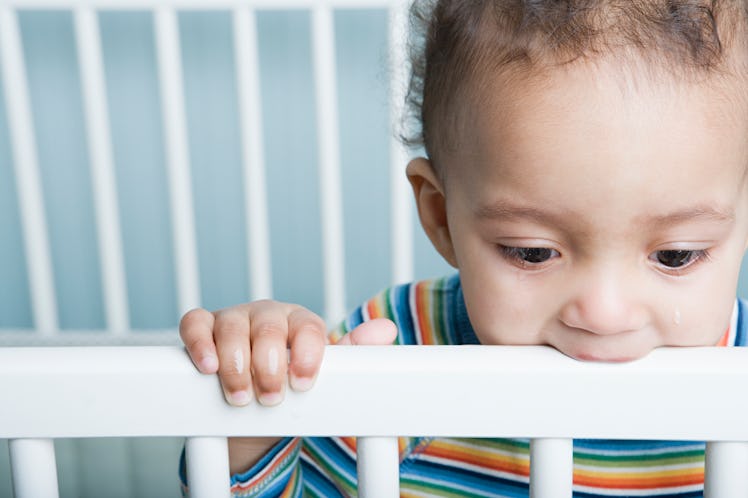How To Stop A Kid From Chewing On The Crib
Babies have always chomped, it’s just that gums don't leave marks. Parents can help by giving kids an appropriate way to relieve their discomfort.

Finding a baby chewing on their crib rail can be disconcerting, particularly if parents are stressing about crib paint or crib damage. But parents who wake to find the crib railing peppered with tiny tooth marks should know it’s not necessarily a cause for concern. Babies use their mouths to analyze the world. It’s called the rooting reflex; anything that brushes against their cheek or lower lip gets a gum job. It’s a natural instinct that doesn’t really cause harm. There’s no reason to rush right out and buy a crib-teething guard.
“Between the ages of 5 and 10 months, a baby’s front teeth are emerging on the bottom and top gums, and a baby is drawn to gnawing on almost anything,” says Melanie Potock, a pediatric speech pathologist and feeding specialist. “By a year of age, because of gnawing on food and other objects, kids can move their jaws in a diagonal motion when chewing food and wide up and down motions on hard surfaces, like the crib railing.”
For babies, chewing on crib railings isn’t merely about discovery. It’s about pain relief. As any parent who has seen those swollen, sore-looking gums — and dealt with a cranky baby — can attest, the teething process HURTS. It’s not just the first round of teething, either. Those toddler molars are hard to reach and can cause a lot of discomfort and frustration, and the process can go on for months.
“Molars begin to erupt between 9 and 15 months, and then come the cuspids peeking out by 18 months of age,” explains Potock. “Those teeth continue to emerge over time, and second molars erupt approximately around 2 years of age.”
Biting serves to soothe babies and help those teeth cut through. But parents don’t have to resign themselves to two years of catching splinters and worrying about the ingredients in crib paint (although please check the annual recall report for peace of mind). Parents can discourage inappropriate gnawing by protecting the crib itself, as well as by supplying the baby with the teethers they need to help relieve discomfort and keep their minds stimulated and exploring.
Extra-large baby-safe silicon guards not only protect furniture, but they also make it hard for most babies to get a good biting angle. They have the added benefit of protecting crawling babies as they start to explore the limits of their mobility.
Make sure the kid has a wide variety of teethers. A variety of shapes and textures is better — differently shaped teethers let babies engage different parts of the jaw, and different textures are just more interesting. For safety, teethers or pacifiers that stay attached to the child should not be used when the child is left unattended. A tether can wind around their fingers, wrist, or neck, causing all sorts of dangerous situations.
Parents can also massage their kid’s gums directly, with a finger or damp toothbrush.
One thing parents can’t do, though, is dissuade a baby from exploring with their mouths. They explore, sense, soothe, and discover — and possibly strengthen their immune system — by using their mouth. It’s not just a comfort instinct for babies; it’s a trend that sticks with a lot of people well past infancy.
This article was originally published on